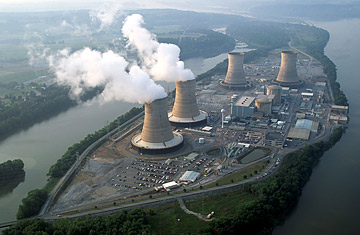
Three Mile Island Nuclear Power Plant
(10 of 11)
The antinuclear movement, already thriving as an amalgam of the intellectually concerned and the idealistic young, who can scarcely find any other cause available that is both so tangible and satisfyingly antigovernment and antiEstablishment, doubtless will now gain new recruits, especially from people who live near the 39 proposed sites for plants across the U.S. In Washington, some of nuclear power's newly acquired friends, reluctantly won over by arguments that atomic plants were necessary to cope with the energy crisis, were wavering. One was Arizona Congressman Morris Udall, chairman of the House Committee on Interior and Insular Affairs, which must approve parts of any Carter energy package. Said Udall after the Three Mile Island accident: "We may have rushed headlong into a dangerous technology without sufficient understanding of the pitfalls." Both Udall and Alaska Senator Mike Gravel demanded an outright moratorium on all new nuclear power plants.
Whether such a drastic step, with all its consequences for America's energy future, might be prudent cannot be determined until both the final outcome and the precise causes of the failure at Three Mile Island are known. By the company's own version of events, there were at least five equipment breakdowns—of valves, pumps and fuel rods. Moreover, the engineers should have been able to cool the reactor to a safe level within twelve hours. Only after the reactor core has fully cooled and the abnormal radiation levels within the container building have been reduced will investigators be able to pinpoint the sequence of mechanical failure, as well as any human mistakes that might have been made. On that issue—human error—there are contradictory statements as well.
But what is already evident is that the engineers at Three Mile Island, for whatever reason, were confronted by a situation they had not foreseen, were uncertain at first how to handle—and most unsettling of all, perhaps did not even understand. At the least, the eight other plants using the same design, and built by the firm of Babcock & Wilcox, might be taken out of operation until the problem is thoroughly analyzed. This is the approach used by the aviation industry, which sometimes grounds all planes of a given model when a dangerous structural or mechanical defect is found in one of them. The potential human tragedy in an aircraft accident, of course, is dwarfed by the possible consequences of a nuclear catastrophe.
President Carter acknowledged the new reality in a talk with a group of editors. He said the accident "will make all of us reassess our present safety regulations ... and will probably lead inexorably toward even more stringent safety design mechanisms and standards." Said Senate Majority Leader Robert Byrd: "We've been assured time and time again by the industry and federal regulatory agencies that this was something that was impossible, that could not happen, but it did happen. There's going to be great difficulty on the part of the American people to feel absolutely reassured about nuclear power."
